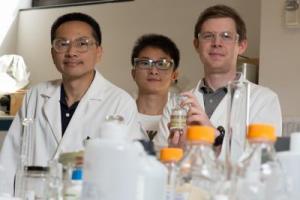Jun 27 2014
Rice University chemical engineer Michael Wong has spent a decade amassing evidence that palladium-gold nanoparticles are excellent catalysts for cleaning polluted water, but even he was surprised at how well the particles converted biodiesel waste into valuable chemicals.
 Rice University scientists (from left) Michael Wong, Zhun Zhao and James Clomburg discovered a palladium and gold nanocatalyst that is faster -- about 10 times faster -- at converting glycerol into high-value products than catalysts of either metal alone. Credit: Jeff Fitlow/Rice University
Rice University scientists (from left) Michael Wong, Zhun Zhao and James Clomburg discovered a palladium and gold nanocatalyst that is faster -- about 10 times faster -- at converting glycerol into high-value products than catalysts of either metal alone. Credit: Jeff Fitlow/Rice University
Through dozens of studies, Wong's team focused on using the tiny metallic specks to break down carcinogenic and toxic compounds. But his latest study, which is available online and due for publication in an upcoming issue of the Royal Society of Chemistry's journal Chemical Science, examined whether palladium-gold nanocatalysts could convert glycerol, a waste byproduct of biodiesel production, into high-value chemicals.
In scientific parlance, the data from the study produced a "volcano plot," a graph with a sharp spike that depicts a "Goldilocks effect," a "just right" balance of palladium and gold that is faster -- about 10 times faster -- at converting glycerol than catalysts of either metal alone.
"We've now seen this volcano plot at least four times now, first with TCE, then with the dry cleaning contaminant 'perc,' and more recently with chloroform and nitrites," Wong said. "The remarkable thing is that the reaction, in each case, is very different."
In previous studies, the nanocatalysts were used in reduction reactions, chemical processes marked by the addition of hydrogen. In the latest tests on glycerol conversion, the nanocatalysts spurred an oxidation reaction, which involves adding oxygen.
"Oxidation and reduction aren't just dissimilar; they're often thought of as being in opposite directions," Wong said.
In chemistry, the role of the catalyst is much like that of a matchmaker; catalysts cause other compounds to react with one another, often by bringing them into close proximity, but the catalysts themselves don't take part in the reaction. Catalysts often speed up reactions that would otherwise happen too slowly, and drugmakers and chemical companies use catalysts to improve the efficiency of their chemical processing. The global market for industrial catalysts is projected to top $19 billion by 2016.
Palladium and gold -- and mixtures of the two -- have long been recognized as extremely effective catalysts. Among catalysts, gold is now valued because it doesn't tarnish or oxidize, a process that can shorten a catalyst's lifespan. Palladium is typically prized because it is especially good at binding and inducing molecules to reduce or oxidize. Wong and colleagues have demonstrated a way to bring these two metals together with better control. They build their catalysts on gold spheres that are about four nanometers in diameter. The spheres are partially covered with palladium, so that the particles' surface contains some gold and some palladium.
Wong and colleagues have shown that covering 60-80 percent of the gold's surface area with palladium typically produces the ideal catalyst -- though the exact percentage varies for different reactions.
"Our synthesis knob, the thing we use to dial in the efficiency, is the coverage area, and the precision of that knob is really what sets us apart from other people who are studying bimetallic catalysis," Wong said. "That precision is what produces these beautiful volcano plots, but it also helps in another way because it allows us to develop a rigorous explanation for the effects that we're measuring."
In the latest study, Wong, Rice graduate student and lead author Zhun Zhao and colleagues from Rice, Argonne National Laboratory and the University of Groningen in Holland used high-powered X-ray spectroscopy and other techniques to show that the "Goldilocks" coverage area for glycerol catalysis was about 60 percent.
"Palladium by itself oxidizes, which is not good because it slows down the catalysis," Zhao said. "We found that the gold in our catalysts helps stabilize the palladium and prevents it from degrading. The catalysts in our tests had extremely high durability. Our best catalyst produced a glycerol product with higher purity and in less time than anything else we found in the literature."
Wong said the research opens up an exciting new area of exploration for his lab.
"Now that we understand how these work with glycerol, we can study reactions of other biomass molecules like glucose, a building block of plants," Wong said.